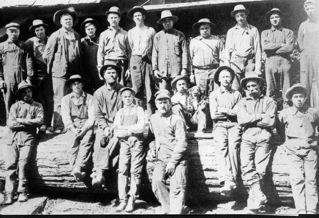[Purdy Pharis, “the Shingle King” had been spending all of his time alone on his 6,500-acre Kings Mountain ranch. He was paranoid, believing people were against him–leading friends to worry about his welfare…..]
The rest of the story came out during testimony before the coroner’s jury. Purdy Pharis’s neighbors Hiram Haskins and Emanuel Stevens were overnight guests of Pharis. In the evening, the men said, they heard a sound coming from Purdy’s bedroom, “like the dropping of a boot on the floor,” followed by moaning.
Early the next morning they again heard moaning. But this time they broke down the door and found their host, Sheldon Purdy Pharis dead.
His revolver lay in front of him, they testified, with one bullet having been fired.
The verdict of suicide was signed by seven of Purdy Pharis’s neighbors, all respectable men who had lived on Kings Mountain for decades.
According to “Sawmills in the Redwoods”, because Purdy Pharis was held in high esteem–and Hiram Haskins was not–the jurors would have been careful to recognize any inconsistencies in his testimony.
Also–Woodside dentist Dr. Tripp confirmed that Purdy Pharis had a troubled mind.
The only possible reason Purdy Pharis would have taken his own life, some believed, was because he was suffering from a mental illness.
Others have noted that the bullet entered the back of Purdy’s head–evidence of foul play. The county coroner ruled suicide but for years a neighbor was believed to have murdered Purdy Pharis. Had the shooting occured today there might have been a different verdict.
At the funeral in Redwood City, crowds came to pay their last respects to the Peninsula’s 19th century Shingle King. Many remained unconvinced Purdy Pharis had [or would] take his own life.
The full story of what happened to Sheldon Purdy Pharis at his Kings Mountain home in 1884 may never be known.

